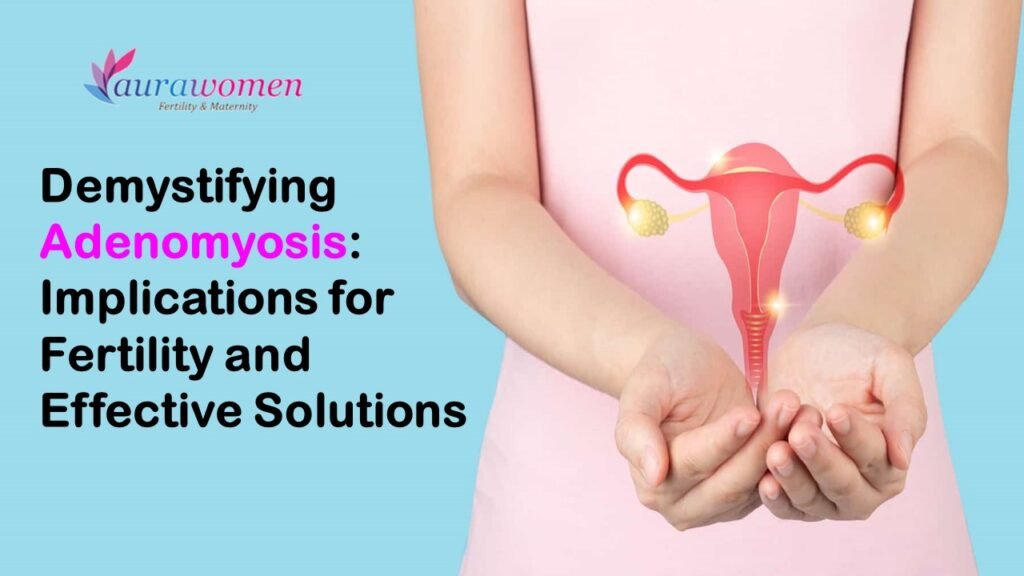
09 May Demystifying Adenomyosis: Implications for Fertility and Effective Solutions
Adenomyosis is a condition where the tissue lining the uterus grows into the muscular wall of the uterus. This can cause the uterus to become enlarged, leading to symptoms such as heavy or prolonged menstrual bleeding, severe menstrual cramps, and pelvic pain.
“Demystifying Adenomyosis: Implications for Fertility and Effective Solutions“

Adenomyosis is a condition that affects the uterus, typically occurring in women of childbearing age. It involves the abnormal presence of endometrial tissue, which normally lines the uterus, within the muscular wall of the uterus (the myometrium). This displacement can lead to a variety of symptoms, including heavy or prolonged menstrual bleeding, pelvic pain, and discomfort during intercourse. The exact cause of adenomyosis is not fully understood, but it’s believed to be influenced by hormonal factors, such as estrogen. Diagnosis often involves imaging studies, such as ultrasound or magnetic resonance imaging (MRI), and treatment options range from medications to surgical interventions, depending on the severity of symptoms and individual patient needs. Adenomyosis can impact a woman’s quality of life, but with proper management, many women find relief from their symptoms.
Regarding pregnancy, adenomyosis can affect fertility in several ways:
- Implantation Issues: The abnormal tissue growth within the uterine wall can interfere with the implantation of a fertilized egg, making it difficult for a pregnancy to establish.
- Uterine Contractions: Adenomyosis can cause increased uterine contractions, which may hinder the implantation process or cause early pregnancy loss.
- Distorted Uterine Cavity: The enlarged uterus due to adenomyosis can alter the shape of the uterine cavity, potentially affecting the implantation of a fertilized egg or increasing the risk of miscarriage.
Must Read – How Endometriosis is different than Adenomyosis?
Resolving adenomyosis often involves a combination of medical and surgical treatments, depending on the severity of symptoms and the desire for fertility:
- Medications: Nonsteroidal anti-inflammatory drugs (NSAIDs) can help manage pain and reduce inflammation associated with adenomyosis. Hormonal treatments such as birth control pills, hormonal IUDs, or GnRH agonists may also be prescribed to help regulate menstrual cycles and alleviate symptoms.
- Surgical Options: In cases where symptoms are severe or fertility is compromised, surgical intervention may be necessary. Procedures such as a hysterectomy (removal of the uterus) or less invasive options like endometrial ablation (destroying the uterine lining) may be considered. However, these options will result in infertility.
- Fertility Treatments: For individuals who wish to preserve fertility, fertility treatments such as in vitro fertilization (IVF) may be an option. IVF involves retrieving eggs from the ovaries, fertilizing them with sperm in a laboratory setting, and then transferring the resulting embryos into the uterus. This bypasses any potential issues with implantation caused by adenomyosis.
Must Read – Clocking Fertility: Understanding the Impact of Age
FAQs (Frequently Asked Questions)
Q: What are the common symptoms of adenomyosis? A: Common symptoms include heavy or prolonged menstrual bleeding, severe menstrual cramps, pelvic pain, discomfort during intercourse, and sometimes, enlargement of the uterus.
Q: How is adenomyosis diagnosed? A: Adenomyosis is often diagnosed through a combination of medical history review, physical examination, and imaging tests such as ultrasound, magnetic resonance imaging (MRI), or sometimes, a pelvic exam.
Q: What are the treatment options for adenomyosis? A: Treatment options vary depending on the severity of symptoms and the patient’s preferences. They may include pain management with over-the-counter or prescription medications, hormonal therapies such as birth control pills or hormone-containing intrauterine devices (IUDs), minimally invasive procedures like uterine artery embolization, or surgical interventions such as hysterectomy.
Q: Can adenomyosis affect fertility? A: Adenomyosis can sometimes impact fertility, although the extent varies among individuals. It may interfere with embryo implantation or cause changes in the uterine environment that affect conception. However, many women with adenomyosis are still able to conceive and carry a pregnancy to term, especially with appropriate medical management.
Q: Is there anything I can do to manage adenomyosis symptoms at home? A: Yes, several self-care measures can help alleviate symptoms. These include applying heat to the abdomen to relieve cramps, practicing relaxation techniques like deep breathing or meditation to manage pain, exercising regularly to improve overall health and reduce stress, and maintaining a healthy diet rich in fruits, vegetables, and whole grains.
Q: What are the potential complications of adenomyosis? A: Adenomyosis itself is not typically life-threatening, but it can lead to complications such as anemia due to heavy menstrual bleeding, chronic pelvic pain that affects quality of life, and in severe cases, it may necessitate surgical intervention.
Q: Is there a cure for adenomyosis? A: Currently, there is no cure for adenomyosis, but there are various treatment options available to manage symptoms and improve quality of life. In some cases, symptoms may improve after menopause when estrogen levels naturally decrease.
Conclusion
It’s essential for individuals experiencing symptoms of adenomyosis, especially if they’re trying to conceive, to consult with your doctor who can provide an accurate diagnosis and recommend appropriate treatment options tailored to their specific needs and circumstances.




No Comments